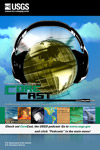USGS CoreCast
USGS Podcasts Home > CoreCast Home Page
Can't see Flash? Install Flash Player.
|
44
|

Early on the morning of May 12, 2008 a magnitude-7.9 earthquake rattled eastern Sichuan, China. Dr. Harley Benz, Scientist-in-Charge at the USGS National Earthquake Information Center, fills us in with the details. (After this interview, the USGS changed its report of this earthquake's magnitude from 7.8 to 7.9.)
Type: audio/mpeg
File Size: 6030975 bytes Duration: 6:12 Released: Mon, 12 May 2008 15:55:24 UTC |
Transcript:
Transcript:
[Music fades in and fades out.]
Scott Horvath
Welcome and thanks for listening to the USGS CoreCast. I'm Scott Horvath. Earlier this morning, there was a 7.8 earthquake that rattled the city of Chengdu in Eastern Sichuan China.
Joining me by phone today is Dr. Harley Benz, Scientist-in-Charge with the National Earthquake Information Center with the USGS.
Harley, thanks for taking the time out of your busy morning to speak with us this morning.
Harley
Good morning and you're welcome.
Scott
So, can you tell us a little bit about the major earthquake that occurred in China this morning?
Harley
Yes, there was a magnitude-7.8 earthquake. It occurred about 90 kilometers or 55 miles west of Chengdu, China, city with a population of more than 2 million people. The earthquake was big enough that it was felt throughout the region, it was felt as far away as Pakistan, Thailand, and Vietnam.
Scott
So are earthquakes in this area of the world or near China uncommon?
Harley
Oh, no no, this is an area that has experienced in the past damaging earthquakes. The most recent damaging earthquake in this area was a magnitude 6.1 earthquake in 1989. And there was a magnitude 7.5 earthquake in 1933 that caused more than 9,000 casualties. So earthquakes in this part of China are infrequent but no unexpected.
Scott
Do you know if this particular earthquake occurred on a known fault or a known-fault structure?
Harley
Well, this is an area that has active seismicity, there is a large basin to the east of this earthquake, it's the Sichuan Basin and the basin is a fault controlled basin. The faults are along the northwest and western side of the basin, and we think that this earthquake occurred on the Longmenshan fault or a tectonically related fault, which is a basin bounding fault.
Scott
Now, I would say there is a lot of information coming out of this, about this earthquake. Where can the public go to get more information on this particular earthquake?
Harley
The public should go to earthquake.usgs.gov. This is the main USGS portal for earthquake information. If you go to that main page, in the upper left hand corner of the Web site, you'll see a link to the magnitude 7.8 eastern Sichuan earthquake.
When you click on that link, you'll go to a series of pages that have a variety of maps, and other kind of content on the historical seismicity, the geology, and information about what people felt in the area; how many people have reported what they felt; the intensity that was reported, but also what people can find there is information on how many people were likely exposed to severe or strong shaking. These can be found on the links to a product that the USGS produces called PAGER (Prompt Assessment of Global Earthquake Response), and there you'll find a map showing the prediction of the ground shaking based on stuff we've done, superimposed on the population of the area and when you combine the two you can get information on the number of people exposed to severe ground shaking or moderate ground shaking.
And for this earthquake there were large numbers of people that were exposed to severe shaking and likely and consequently, there was likely damage from this earthquake.
Scott
And all of that information is available on the earthquake Web site through those maps right now?
Harley
That's right.
Scott
Great, excellent. Is there anything else you would like to add that I didn't already ask you?
Harley
Yes. For this earthquake, because of its size, we should expect to see lots of aftershocks. Often the media will ask us or the public will say, how long will we feel earthquakes and how big will they be? [Scott: Right.]
When the first few hours following the magnitude 7.8, we recorded more than 13 earthquakes, the largest being a magnitude 6. The earthquakes are being located along a northeast trending fault, and they extend over a region about 100 kilometers or 60 miles, which is consistent with the size of this earthquake.
In terms of the total number of aftershocks, aftershocks form an earthquake, typically this size, will be occurring weeks and months from now, but typically with time, the number of earthquakes will go down, and the size of the earthquakes will go down, but there are chances of having other large, damaging earthquakes as part of this sequence occurring in the new few days and weeks. There is a potential for that.
Scott
Well, Harley, thank you for very much for providing us with that great information and thanks for joining us this morning on the phone.
Harley
You're welcome.
Scott
And that does it for this episode of the USGS CoreCast. Thanks for listening and don't forget to visit our web site at usgs.gov/corecast where you can find more information, links, and transcription for this episode and other episodes in the past.
And just as a reminder, the USGS CoreCast is a product of the U.S. Geological Survey, Department of the Interior.
Until next time, I'm Scott Horvath saying "keep it cool."
[Music fades in and out]
Music credit:
"A Mastermind's Plan of Evil" by Edgen
Resources related to this episode:


